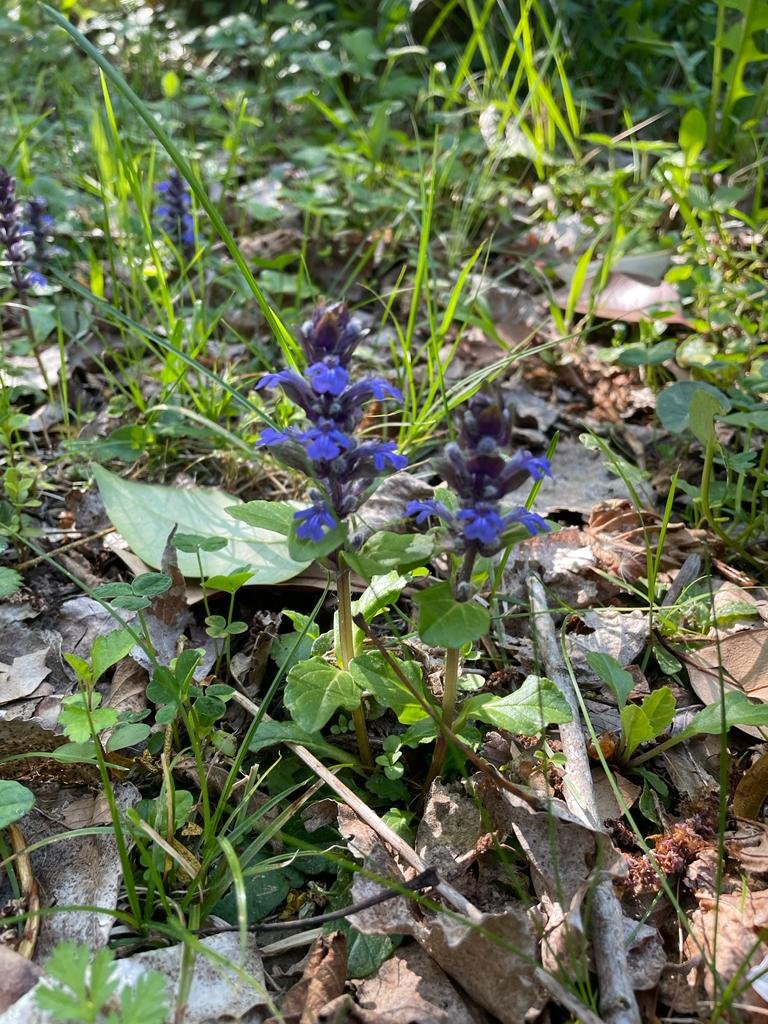Flora and Fauna
The River Festival celebrates the natural resources of the area. They are abundant. This is the first of a series of blogs about the surrounding flora and fauna and some of the more unusual uses for beautiful and sometimes common plants in the area. Many are edible, some not and several have medicinal qualities. We start with three abundant species, Greater Celandrine, Greater Stitchwort and Carpet Bugle to be found mainly in moist areas so love to grow around rivers.
Greater Celandrine
The greater celandine is found often along roadsides and banks of water. I found this beautiful clump by the side of the River Hers on a walk past the allotments opposite Lola’s Grove. The plant with its curved leaves and yellow flowers is an old proven herb for warts and other skin complaints. Especially the orange milky juice, which is found in the stems and leaves of greater celandine, plays a major role. However, when using the herb, there is a lot to consider, as the milk juice and some other plant constituents can be toxic.
The scientific name of greater celandrine is Chelidonium majus and this comes directly from the Greek word for swallow, chelidon, as ancient writers noted that the celandrine appeared with the swallows and disappeared when they left, hence one of their nicknames being swallowwort.
They are part pf the poppy family (Papaveraceae) and are also known as nipplewort, and tetterwort. They flower from April to October and the leaves, flowers, juice and roots are useful medicinal plant parts. Fond of sunny to partially shaded areas, they thrive in nutrient-rich, loose soil. Some of their uses as a medicinal herb are for warts, gall bladder problems, eczema and stomach cramps. Nevertheless, one should know, especially with self-treatments, that the herb is slightly poisonous and is also listed as a poisonous plant.
The natural habitat of greater celandine is to be found in Northern and Central Europe. Today it is represented in almost all European countries as far as West Asia. The herb is grown today also on a larger scale in North America and is accordingly frequently found there. It came to North America in the early modern era by settlers and merchants.
In the wild one finds the plant mostly in regions that are slightly to moderately moist. These include close to the banks of streams and rivers, extensive meadows with higher nutrient supply, roadsides or at dumps and walls.
While the greater celandine belongs to the poppy family, the lesser celandine belongs to the buttercup family.
The greater celandine reaches stature heights between 30 and 75 cm (12 and 30 in) and is a perennial plant. In rare cases, however, it survives as a two-year herb. Its roots are rather flat and form a dense network of yellowish brown to brown root hairs. The root hairs arise from the dark brown to almost black rhizome, a subterranean thickened shoot axis.
Striking are the pinnate (feather-like) and almost kidney-shaped leaves of greater celandine with their notched leaf margins. The underside of the leaves is covered with a few glandular hairs. The leaves are alternatingly arranged on the stem. Petioles and the shoot axis (stems) are interspersed with fine milk tubes, which releases a yellowish milk juice when injured. This milk juice is poisonous due to its acrid effect. The stalk is usually conspicuously hairy.
In the flowering period, which is generally expected between mid-May to early October, the greater celandine produces its own golden-yellow flowers. The appearance and the colour of the flowers are reminiscent of the St. John’s wort (Hypericum perforatum). In contrast to this, the hermaphroditic flowers only consist of four petals and numerous stamens. Rarely flower mutations can form, so that a greater celandine flower can consist of up to 6 petals.
Subsequent to the fruit ripening from the flowers form delicate capsule fruits, which look like greenish pods. The fruits can be up to 5 cm (2 in) long and contain numerous black to slightly oval-shaped seeds. On the seed is still a whitish attachment, which is referred to in the botanical sense as elaiosome. This suggests that the seeds are mainly spread by birds or ants.
Carpet bugle
Carpet, or common, bugleweed (Ajuga reptans) forms colonies of rosettes of dark green oval leaves in damp meadows or woodlands. It produces short spikes of blue, or occasionally pink or white, flowers on stems up to 30 cm (12 inches) long and uses stolons (runners) to spread vegetatively. Ground pine, or yellow bugle (A. chamaepitys), is shorter and has yellow flowers and three-parted needlelike leaves that are pine-scented.
Bugleweed is edible. Bugleweed shoots can be eaten raw in salads or sautéed. The leaves can be steeped in tea, eaten in salads or added to casseroles. Traditionally, Native American tribes ate the roots of the bugleweed plant. When boiled, the roots are said to taste like Chinese artichokes.
Bugleweed can be used on the skin. Bugleweed has a long history of use in ointments and medicated oils to help heal the skin.
Greater Stitchwort
Greater stitchwort grows in woodland and along roadside verges, hedgerows and grassy banks. It has many other common names, including 'wedding cakes', 'Star-of-Bethlehem', 'daddy's-shirt-buttons' and 'snapdragon' - the latter because its stems are brittle and easily break. Its pretty, star-shaped, white flowers bloom from April to June; as the seed capsules ripen, they can be heard 'popping' in late spring.
How to identify
Greater stitchwort has five white petals, each deeply notched and almost divided into two. Its green leaves are grass-like in appearance and its brittle stems are square. Greater stitchwort has larger flowers (2-3cm across) than its relative, Lesser stitchwort (0.5-1cm across).
They taste a little like lettuce mixed with grass. The leaves are quite small and it can take an age to get a good amount but Stitchwort can be found growing in abundance so there will be a lot of it there.
The flowers have a mild taste but look fabulous in salads.
The medicinal uses of greater stitchwort can be to treat ‘stiches’ caused by walking or running without stretching first. It was thought that picking the flowers would bring on a thunder storm and the roots can be used to make a dye.





